The Element Strategy Initiative Holds First Exhibit at nano tech 2019
The Element Strategy Initiative Holds First Exhibit at nano tech 2019
The Element Strategy Initiative: To Form Core Research Centers participated in its first booth exhibit for nano tech 2019 held at Tokyo Big Sight on Jan. 30 – Feb. 1, 2019 (Wed–Fri) to present an overview of the initiative and highlight key achievements at the four research centers.

Exhibition Reports
The Elements Strategy Initiative Center for Magnetic Materials (ESICMM)
ESICMM displayed a single panel entitled “Rare-Metal-Lean Permanent Magnets.” Together with models encased in clear plastic that were created using a 3D printer to illustrate the crystalline structures of rare-earth permanent magnets and the role that electronic structure plays in magnetism, the exhibit was effective in drawing the attention of many visitors. The exhibitors showed how basic principles of magnets and data from first-principles calculations were being used to search for optimal materials.
One visitor asked about the possibility of developing a technique for designing materials using processing elements to determine magnetic performance, while others voiced a desire to perform their own computations. There were also many substantive questions on the potential for calculating texture, complex structures at interfaces, and the properties of magnetic materials, and on the feasibility of rare-earth-free permanent magnets. Some visitors requested that the center hold a seminar and others discussed the need to develop small high-performance magnets for electronic scales.
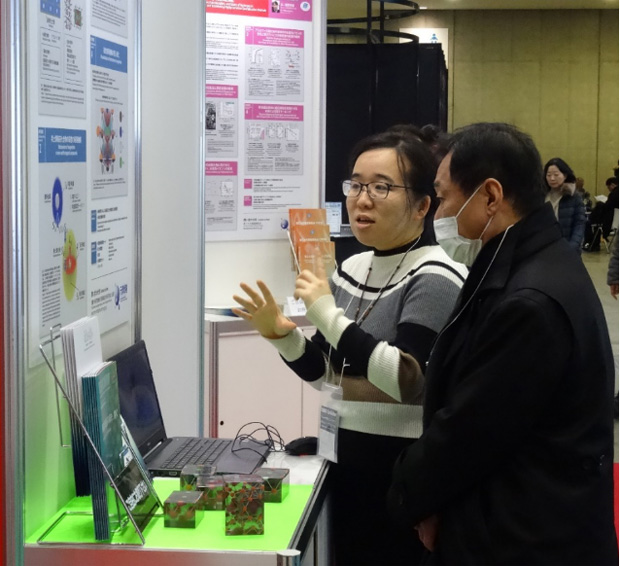
Tokodai Institute for Element Strategy (TIES)
TIES exhibited two panels that were entitled “Unraveling the Roles, Functionalities, and States of Hydrogen in Condensed Matter and Establishing Highly Sensitive Quantification Methods” and “Creation of Novel-Function and High-Performance Electronic Materials Based on Novel Concepts for Materials Design.” We handed out 140 compilations of our research results, despite them being quite hefty. Each day of the conference, between 20 and 30 people stopped by for an extended period of time to hear our explanations and engage in discussion.
The visitors to this booth can be broadly categorized as (1) those interested in precise research results, (2) those interested in searching materials using materials informatics and other methods, (3) those who are or used to be engaged in this field, (4) those wishing to assert the needs of businesses, and (5) those involved in research centers and universities. Approximately 70% of the people who dropped by our booth were in industry, including the automotive industry.
Topics that drew a particularly large amount of attention were (1) ultrahigh-sensitivity measurements of hydrogen content, (2) hydrogen anions present in substances, (3) searches for new materials based on new concepts for materials design including materials informatics and molecular orbital methods, (4) novel high-performance electronic materials for flat-panel displays, and (5) electrides for use as catalysts.
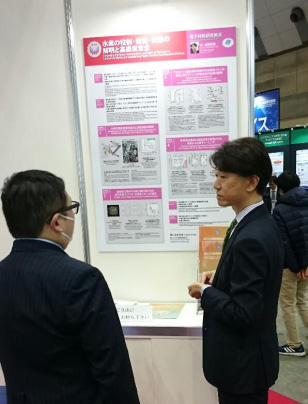
Elements Strategy Initiative for Catalysts and Batteries (ESICB)
ESICB displayed two panels entitled “Fire-Extinguishing Organic Electrolytes for Safe Batteries” and “Development of Novel Automotive Catalysts Using Less Noble Metals.” Next to the battery panel, a stunning video showing electrolytes being applied to fire and extinguishing the flames caught the eyes of passersby. In combination with the Element Strategy Initiative, ESICB handed out approximately 250 pamphlets.
Some of the visitors to the booth were researchers and students in specialized fields who were interested in the research area and sought out technical explanations, but many non-experts from related businesses also stopped by and showed sincere interest in the new technologies. For example, manufacturers of production equipment for lithium-ion batteries wanted to know about our current proposals, while recyclers of precious metals who came by to gather intelligence on the future direction of catalysts offered suggestions on the trial production of new catalysts.
Visitors from overseas were also impressed with our research. After the exhibition ended, we continued to exchange email with some overseas researchers, introducing them to the researchers in our project. In one case, the researchers came to visit in person at Kyoto University. Thus, the conference provided us an opportunity to spread our novel scientific theories to industries both in Japan and overseas.
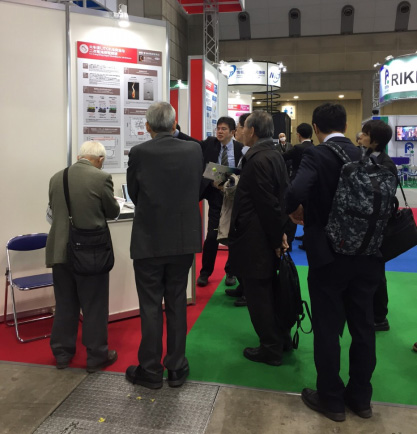
Elements Strategy Initiative for Structural Materials (ESISM)
ESISM displayed one panel entitled “Concurrent Enhancement of Strength and Ductility in Bulk Nanostructured Hexagonal Metals.” Using titanium and magnesium alloys as examples, we explained the mechanisms of high-strength and ductility and introduced the new concept of plaston.
One of the most unexpected and lasting impressions at the conference was having the opportunity to delve deeply into technical discussions with personnel from the research division of a materials manufacturer who had experience trying to improve ductility in hexagonal metals. Several students also visited the booth and showed great interest when we described the Element Strategy Initiative. Having an opportunity to participate in an exhibition such as this is important because it also helps cultivate young researchers.
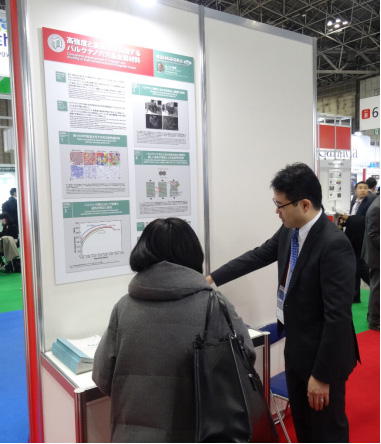
Introduction to the Element Strategy Initiative: To Form Core Research Centers
An overview of the initiative was presented in a panel entitled “O Mo Te Na Si, Being Hospitable Hosts to the Earth.” The novel design of this poster had a different impact from those serving to introduce research results, particularly on university students and other young people who visited our booth after being drawn by the poster design.

Presentations
Among the presentations given at the Seeds & Needs Seminar B corner in the exhibition hall, Program Officer Tomohiro Nakayama (JST) provided an overview of the Element Strategy Initiative: To Form Core Research Centers, and Dr. Atsuo Yamada (the University of Tokyo) gave a lecture on fire-extinguishing electrolytes for lithium-ion batteries. Following the lectures, many of the people in attendance visited the Element Strategy Initiative booth, which was located near the seminar corner.
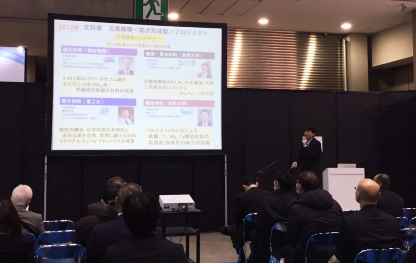
About nano tech 2019
Panel exhibits for each center
Description sheet for each center (in Japanese)
Description sheet for each center (in English)